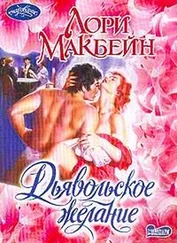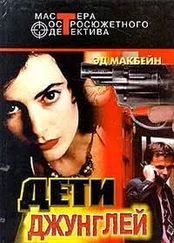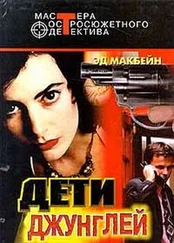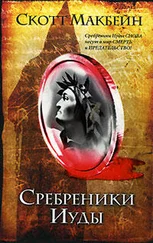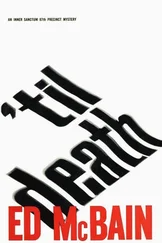Three minutes passed. Five.
Cautiously, he stepped over Reardon’s body, flattened himself against the wall, and edged his way past the telephone. The door to the adjacent small room was partially open. He could see a hot plate on a counter and above that a hanging wall cabinet. He shoved the door wide and allowed his gun hand to precede him into the room. It was empty. He came back up the corridor, stepped over Reardon’s body again, and looked into the main storage area. Sodden ashes and charcoal, scorched metal tables, broken hanging light fixtures, nothing else. He kept the gun in his hand, went to the entrance door, and threw the slip bolt with his elbow. Ignoring Reardon for the moment, he went back to the small room in which Lockhart and Barnes had brewed their coffee and tippled their sauce. In the cabinet, he found a fifth of cheap whiskey. He put the gun down momentarily, wrapped part of his handkerchief around the neck of the bottle, a corner of it around the screw top, and twisted off the cap. Chloral hydrate has a slightly aromatic odor and a bitter taste, but all he could smell was alcohol fumes, and he wasn’t about to take a swig of whatever was in that bottle. He screwed the cap back onto the bottle, put the handkerchief back into his pocket, and the .38 back into its holster. He tagged the bottle for later transmittal to the lab, and debated whether or not he should call Andy Parker and suggest that not only had he missed the probable cause of the fire, but he had also overlooked a bottle that most likely contained a sizable quantity of CC1 3CH0.H 20. He went out into the hallway again.
Reardon was still lying on the floor, and Reardon was still dead.
The first bullet had taken him in the right cheek, the second one just below his nose, in the upper lip. The hole in the cheek was neat and small, the one below the nose somewhat messier because the bullet had torn away part of the lip, shattering teeth and gum ridge with the force of its entry. Carella didn’t know any medical examiner who would risk his reputation by estimating the size of the bullet from the diameter of the hole left in the skin; bullets of different calibers often left entrance wounds of only slightly varying sizes. Nor did the size of the entrance wound always indicate from what distance the gun was fired; some small-caliber contact wounds, in fact, looked exactly like long-range shots. But there were powder grains embedded in Reardon’s cheek and around his mouth, whereas there were no flame burns anywhere on his face. Carella guessed he’d been shot from fairly close up, but beyond the range of flame.
His initial supposition was that Reardon had opened the door on his killer and been surprised by a quick and deadly fusillade. But that didn’t explain the unlocked gate in the cyclone fence. That gate had been padlocked when Carella visited the warehouse earlier today, and Reardon had opened it from the inside with a key from his belt ring. He had locked the gate again before leading Carella to the warehouse, and when the visit was over, he had walked back to the gate, unlocked it, let Carella out, and immediately locked it behind him again. So how had the killer got inside the fence? He would not have risked climbing it in broad daylight. The only answer was that Reardon had let him in. Which meant one of two things: either Reardon had known him and trusted him, or else the killer had presented himself as someone with good and valid reasons for being let inside.
Just inside the entrance door, Carella found two spent 9-mm cartridge cases, and left them right where they were for the moment. He went to the wall phone and dialed the precinct. He told Lieutenant Byrnes that he’d left Frank Reardon at approximately 1:30 that afternoon, and had returned to the warehouse not ten minutes ago to find him dead. The lieutenant advised Carella to stay there until the Homicide boys, the man from the ME’s office, the lab technicians, and the police photographer arrived, which Carella would have done anyway. He asked if Hawes was back from Logan yet, and the lieutenant switched him over to the squadroom outside.
“Get anything up at Grimm’s house?” Carella asked.
“Just one thing that may or may not be important,” Hawes said. “There were no lights on until just before the fire.”
“That may tie in with what I found here.”
“You think it’s the old electric-bulb gimmick?”
“Could be,” Carella said. “I’ve also got a bottle that may or may not have chloral hydrate in it, a pair of spent 9-mm cartridge cases...”
“Oh-oh,” Hawes said.
“Right. We’ve got a homicide, Cotton.”
“Who?”
“Frank Reardon, day watchman here at the warehouse.”
“Any idea why?”
“Probably to shut him up. It’s my guess he doctored the booze the night watchmen would be drinking. Do me a favor and run a routine check on him, will you?”
“Right. When’re you coming back here?”
“The loot’s contacting the clean-up boys now,” Carella said. “Knowing them, I’ll be here at least another hour. One more thing you can do while I’m gone.”
“What’s that?”
“Run a check on Roger Grimm, too. If this was an inside job...”
“Got you.”
“I’ll see you later. Few things I’ve got to tag and bag before the mob arrives.”
“Take your time. It’s very quiet up here right now.”
It was not quiet when Carella got back to the squadroom at a quarter to six. Detectives Meyer and Brown had already come in to relieve the skeleton team, and they were busy in the corner of the room, yelling at a young man who sat with his right wrist handcuffed to a leg of the metal desk. Hawes was sitting at his own desk, oblivious of the noisy confrontation going on behind him. He looked up when Carella came through the gate.
“I’ve been waiting for you,” he said.
“So do you want a lawyer or don’t you?” Brown shouted.
“I don’t know,” the young man said. “Tell me my rights again.”
“Jeee-sus Christ !” Brown exploded.
“Took a little longer than I expected,” Carella said.
“As usual,” Hawes said. “Who’d Homicide send over? Monoghan and Monroe?”
“They’re on vacation. These were two new guys, never saw them before. What’d you get from the IS?”
Meyer Meyer, hitching up his trousers, walked over to Hawes’s desk. He was a burly man with china-blue eyes and a bald pate, which he mopped now with his handkerchief as he sat on the edge of the desk. “Explained his rights four times,” he said. He held up his right hand like an Indian war bonnet. “ Four goddamn times, can you imagine it? He still can’t make up his mind.”
“Screw him,” Hawes said. “ Don’t tell him his rights.”
“Yeah, sure,” Meyer said.
“What’d he do?” Carella asked.
“Smash-and-grab. A jewelry store on Culver Avenue. Caught him with six wristwatches in his pocket.”
“So what’s with the rights? You’ve got him cold. Book him and ship him out.”
“No, we want to ask him some questions,” Meyer said.
“What about?”
“He was carrying two decks of heroin. We’d like to know how he got them.”
“Same way as anybody else,” Hawes said. “From his friendly neighborhood pusher.”
“Where’ve you been?” Meyer said.
“On vacation,” Hawes said.
“That explains it.”
“Explains what?”
“Why you don’t know what’s going on.”
“I hate mysteries,” Hawes said. “You want to tell me what’s going on, or you want to go back and explain that kid’s rights to him?”
“Brown’s doing that,” Meyer said, glancing over his shoulder. “For the fifth time. I’d better go see if he’s making any progress there,” he said, and walked back to where Brown was patiently explaining Miranda-Escobedo to the addict, who kept looking up at him solemnly.
Читать дальше




